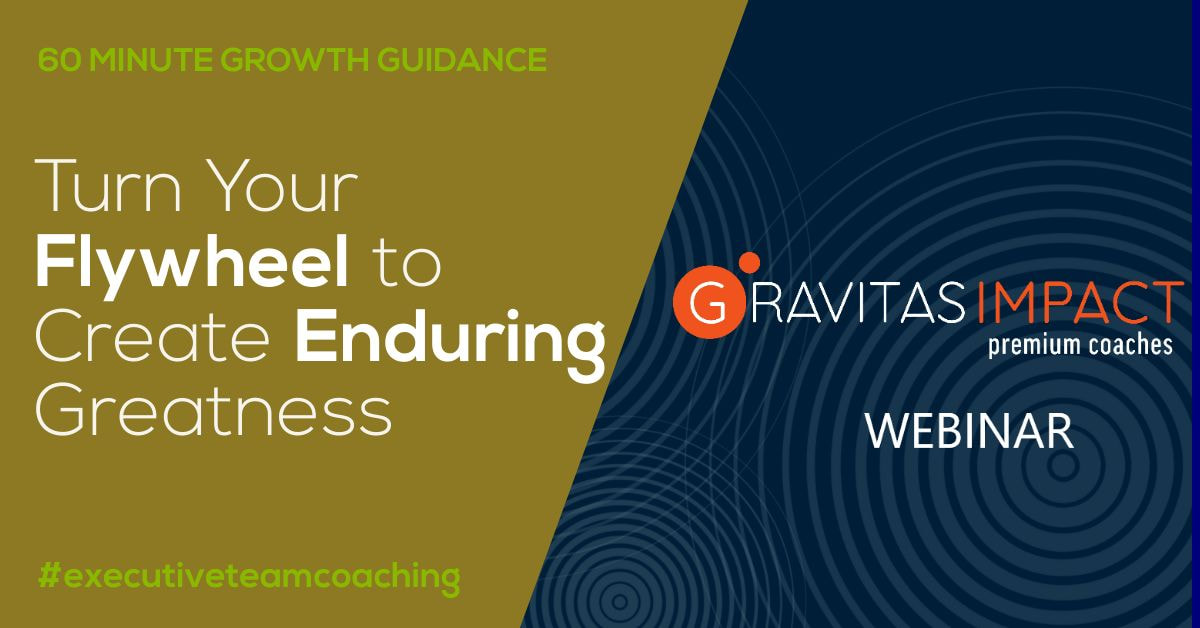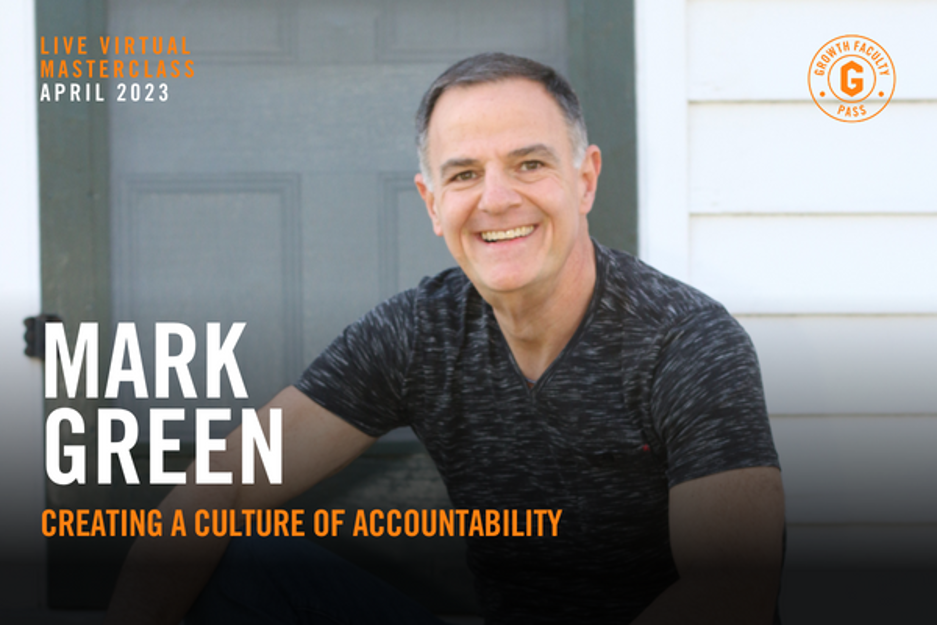|
In a recent article, I wrote about the three basic elements of a successful strategy. I also mentioned that CEOs and their leadership teams can use other tools and practices to refine their strategy and make it more robust over time. Jim Collins’ flywheel concept, from his best-selling book Good to Great, is one of those refinement tools we use with midsize companies. This Gravitas Impact Premium Coaches webinar by certified coach and colleague Paul Cronin, in Minneapolis, Minnesota, covers how to apply the flywheel concept to strengthen a company’s strategy. In this 60 minute “under the covers” webinar, Paul explains the flywheel concept in detail and how it connects with the 3 key disciplines outlined in Good to Great, shares some great examples of flywheels (including his own as a coach - which, not coincidentally, is very similar to my own), and describes a process for discovering and developing your flywheel. How can you improve your strategy?
To find out what you can improve in your strategy to grow more easily, quickly and profitability, try our complimentary Agile Growth Checklist. This self-service questionnaire takes 5 to 10 minutes to complete. You'll receive the checklist with your responses immediately. Within 24 hours, you'll receive a compiled report highlighting areas to improve. Complete section 3 and 6 to check your strategy and customer processes. Complete section 4 to check your execution. Or complete all 7 sections to find out how your company is doing in each of the 7 areas needed to produce more rapid, profitable and sustainable growth. This report is complementary and involves no obligation. End the cycle of fire-fighting work problems With our partner Growth Faculty, we offer you a 10% discount for Creating a Culture of Accountability - Live Virtual Masterclass with Mark Green. Accountability is a challenge for most of us. 84% of team members “try but fail” or “avoid” accountability, and 80% of people see accountability as punishing. (1) Over a 90-minute masterclass, leadership growth coach and author Mark Green will show how to close the costly and frustrating accountability gap. “An accountable employee owns their outcomes.” – Mark Green Mark is author of Activators – a CEO’s Guide to Clearer Thinking and Getting Things Done and Creating a Culture of Accountability. “WOW, WOW, WOW! That was an excellent and inspiring presentation. I am going to feed the right beast now!” – Liam Bailey, past Mark Green masterclass attendee Tuesday, April 18, 2023 - 4pm in MB, 3pm in SK NON-MEMBER: $130* | OUR NETWORK: $115* *Prices quoted in USD.
What can you do to create your accountability culture?
To find out what you and your leadership team could do to grow more easily, quickly and profitability, AND enjoy the ride, try our complimentary Agile Growth Checklist. This self-service questionnaire takes 5 to 10 minutes to complete. You'll receive the checklist with your responses immediately. Within 24 hours, you'll receive a compiled report highlighting areas to improve. Find out how your company is doing in each of the 7 areas needed to produce more rapid, profitable and sustainable growth. This report is complementary and involves no obligation. I’m always delighted when I read a Patrick Lencioni book. I enjoy both his clear take on things and his user-friendly writing style. So reading his best-seller, The Five Dysfunctions of a Team, was a no-brainer. In the business fable style that Lencioni is famous for, he tells the story of the leadership team of a technology company. In it, he shows how leadership teams can use his simple model to deliberately improve their alignment, execution and results. Lencioni covers the five critical dysfunctions of a team, which each build on the other. They include: 1) absence of trust - not feeling comfortable being open, vulnerable and real - which leads to 2) fear of conflict - leaving things unsaid and avoiding sharing differing opinions - and therefore 3) lack of commitment - team members don't feel decisions are appropriate or feasible - which results in 4) avoidance of accountability - hiding performance, blaming or making excuses - and therefore 5) inattention to (team) results - not focusing on true progress and organizational impact. After the story, further details on the model follow with tips for working on each dysfunction. Out of all the team effectiveness frameworks I’ve studied and used, this one is the simplest. Yet, it’s still completely relevant and applicable. The Five Dysfunctions framework is also one of the tools in the Scaling Up system and the 7 Attributes of Agile Growth framework that we use with CEOs and leadership teams of mid-sized prairie-based companies. Book: 229 pgs, 3h45m audio. Soundview Summary: 8 pgs, 19m audio. Get-Abstract summary: 5 pgs, 10m audio. How can you strengthen your leadership team? To find out what you can improve in your leadership team to grow more easily, quickly and profitability, try our complimentary Agile Growth Checklist*. This self-service questionnaire takes 5 to 10 minutes to complete. You'll receive the checklist with your responses immediately. Within 24 hours, you'll receive a compiled report highlighting areas to improve. This report is complementary and involves no obligation. Complete section 1 and 4 to check your leadership team* and accountability processes*. Or complete all 7 sections to find out how your company is doing in each of the 7 areas needed to produce more rapid, profitable and sustainable growth. *All of Patrick Lencioni’s best practices are included in our Agile Growth Checklist, as well as many others developed by world-renowned business leaders, researchers and professionals. In the previous 5 Minute Growth Tip article, I wrote about how midsize companies can make more progress at implementing the processes and systems that will enable them to grow and grow profitably. But is it really progress if you’re not going in the right direction? And how do you know if you are going in the right direction?
While various types of processes and systems are needed to grow beyond a company’s current level (see the first article in this series), some types of systems will need to be chosen (or tailored) specifically for that unique business AND to support and execute its strategy in the market. Developing a clear strategy is not only important to making the right progress. It’s also important for ensuring a company is pursuing truly valuable growth opportunities. This brief article will cover the basics of clarifying and strengthening your strategy. From there, other tools and practices can be used to refine the strategy and make it more robust over time. The strategy misconception First, let’s recognize what strategy is NOT. As Jack Welch once put it, “Strategy is NOT a lengthy action plan. It is the evolution of a CENTRAL IDEA through continually changing circumstances.” A list of projects, priorities or action items is not strategy. That’s an execution plan. And what is this “central idea” Jack speaks of? I’ve been facilitating strategy development for 17 years. In all that time, the simplest, most accurate description of strategy I have come across is from Michael Porter, the renowned Harvard Business School professor, researcher and consultant. In his best selling book “Competitive Advantage”, Porter describes strategy succinctly as “a unique and valuable position in the market that involves a different set of activities from competitors”. Your “unique and valuable position in the market” is this “central idea”. And it needs to continually evolve to respond to changing circumstances. It describes the essence of the business you and your leadership team want to build. Your execution plan is how you’ll build it. Thinking of strategy as what needs to be done, rather than a vision for the business you are building, results in directionless busyness. Imagine building a house with no clear blueprints. How confusing would that be? It’s the same in a company. More Than Unique Let’s look at what Porter calls a “position in the market.” Put simply, this is about how your offering compares to competitors who offer the same or similar products or services. In the Scaling Up system and the 7 Attributes of Agile Growth, we use the term “Differentiation”. For most business leaders, like myself, it’s been drilled into our heads that our business needs to be unique. Porter confirms that this is important for our positioning. But why? To create customer loyalty. If our customers can only get our unique twist on a product or service from us, and they can’t get it from our competitors, they’ll keep coming back. Hence the more traditional terms used for Differentiation, including Unique Value Proposition, Unique Selling Proposition, Unique Offer and Competitive Advantage. They all essentially mean the same thing - a brief statement that describes how our product or service is or will be unique from our competitors. One example is SouthWest Airlines. While they provide air travel services like so many other airlines, they have clear differentiation, which is captured in their brand promise: “Low Fares, Lots of Flights, Lots of Fun”. This is unique in the american airline business. Yet Porter’s definition means our differentiation needs to be more than unique. It also has to be valuable. Valuable to who? Customers. Getting Focused This can be tricky. Because what’s valuable to one type of customer is not necessarily valuable to another. To make our differentiation valuable to a customer, we need to know WHO that customer is. Once we’re clear on who that customer is, we can define our differentiation, and then design our “different set of activities”, as Porter puts it, to consistently deliver that unique positioning. Note that, if we are to do things differently than competitors, to deliver on our differentiation for a specific type of customer, the number of different types of customers we serve has to be pretty small. Doing things in a number of unique ways that are each valuable to different types of customers becomes unprofitable, if not impossible, without sufficient scale. So for many companies, especially midsize companies, that often means focussing on one type of customer. We call them our Core Customer. How do we identify our core customer? We examine our best customers! The ones who are the most profitable, the most loyal, the most likely to refer, the ones who pay on time. In addition to knowing WHO are core customer IS, we have to know WHAT our core customer NEEDS. This enables us to then define differentiation that will be valuable to them. Without understanding our core customer’s needs, we’re just guessing. With clarity about who our core customer is, what they need and what differentiation would be valuable to them, we also want to make sure we can deliver on that differentiation. Maybe we aren’t fully set up right now to deliver on it. But we need to examine if we can get there. Regardless of our differentiation, those unique activities needed to deliver it need to be doable. If not, when we market our offering based on that differentiation, we’ll be making a promise to customers that we just can’t keep. Customers will be disappointed and become less loyal, rather than more loyal, over time. What Sandbox to Play In The Sandbox defines what specific products or services we’re going to offer, where we’re going to sell them, and through who. Through direct sales? Online? Through distributors, affiliates or retail? The Sandbox encourages us to proactively think through where our focus for growth needs to be over the next 3 to 5 years. It encourages focus also by proactively deciding to avoid products, geographies and distribution channels that will distract us. We may even choose to discontinue some we have right now. Choosing our Sandbox involves making sure these “what?”, “where?” and “through who?” decisions align with 1) our core customer, 2) our differentiation, and 3) our understanding or estimates of what products, geographies and distribution channels will provide the greatest opportunities for growth and profitability. SouthWest Airlines, for example, has determined that offering a first class service would not fit. It would take away from their “Lots of Fun” promise by treating some customers more lavishly than others. It would also increase complexity which would lengthen ground time, reduce the number of flights per day - “lots of flights”, and therefore increase costs and affect their “Low Fares” promise. Making it Work The three basic elements of a successful competitive strategy include:
This basic strategy work will be most successful when aligned with four foundational pieces: 1) our core purpose (or our Why, as Simon Sinek calls it - the difference we want to make in the world beyond creating jobs and profit), 2) our vision (or Big Hairy Audacious Goal - BHAG - as Jim Collins puts it - a 10 to 30 year company goal that is bold but stimulates innovation and progress), 3) our 3 year strategic targets - including financial, non-financial, - and 3 year highly achievable goal (or 3HAG as Shannon Byrne Susko calls it) that defines what we want the company to look like, 4) an awareness and understanding of the trends unfolding in our market and the world. And let’s remember, as CEOs, we’re best off developing our strategy collaboratively with our leadership team, in order to achieve “efficient leadership team buy-in” that supports “accountability for execution” (as discussed in my previous article). From there, we can develop our one year and quarterly execution plan to bring our strategy to life. With the right leadership team members and the right culture, we can execute with efficiency and predictability. AND, with the right leadership team members and culture, we are much more likely to develop a great strategy with that team. More about that in my next 5 Minute Growth Tip article. How can you improve your strategy? To find out what you can improve in your competitive strategy to grow more easily, quickly and profitability, AND enjoy the ride, try our complimentary Agile Growth Checklist. This self-service questionnaire takes 5 to 10 minutes to complete. You'll receive the checklist with your responses immediately. Within 24 hours, you'll receive a compiled report highlighting areas to improve. Complete sections 3 and 6 to check your competitive strategy. Or complete all 7 sections to find out how your company is doing in each of the areas needed to produce more rapid, profitable and sustainable growth. This report is complementary and involves no obligation. |
Archives
December 2029
Categories
All
|






 RSS Feed
RSS Feed
